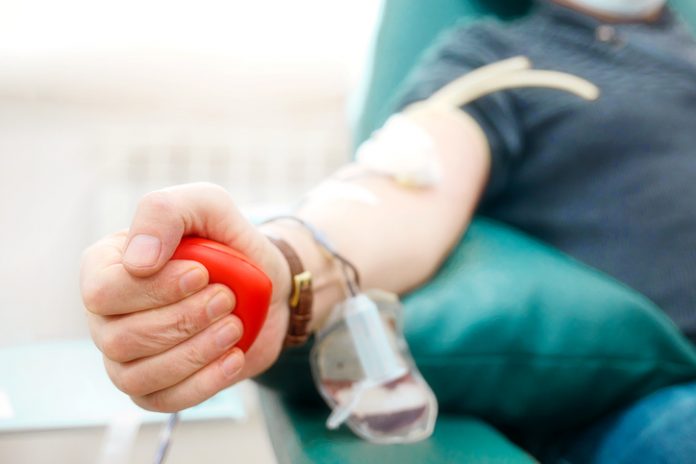The Food and Drug Administration (FDA) has proposed changes to blood donor eligibility guidelines to include more gay men.
The new FDA guidance to donation centers would replace the waiting period before a man who has had sex with a man, or a woman has had sex with a gay man can give blood with “gender-inclusive, individual risk-based questions.”
The current donor history questionnaire would be revised to ask all prospective donors if they have had sex with new or multiple partners in the past three months and, if so if that included anal sex. Blood donations from individuals who answer those questions affirmatively would be deferred for three months.
‘Deferred Permanently’
In the 1980s, during the AIDS (Acquired Immune Deficiency Syndrome) epidemic, the FDA banned any man who had ever had sex with a man from donating in order to reduce transfusion-transmitted infections with the Human Immunodeficiency Virus (HIV).
In 2015, the ban was replaced with a one-year waiting period and, during the COVID-19 pandemic, the deferral was reduced to three months.
The new guidance would not change other HIV-related waiting periods or bans, the FDA stated in a press release on January 27.
“No change in the donor deferral time periods for other HIV risk factors, including for individuals who have exchanged sex for money or drugs or have a history of non-prescription injection drug use,” states the FDA press release. “Any individual who has ever had a positive test for HIV or who has taken any medication to treat HIV infection would continue to be deferred permanently.”
Most developed countries defer donors at high risk for carrying HIV and developing AIDS, which is highly fatal, despite the availability of therapies.
Prepping for Unsafe Sex
Blood donations from those taking oral medications to prevent HIV infection—pre-exposure prophylaxis (PrEP) or post-exposure prophylaxis (PEP)—would be deferred for three months from their most recent dose, under the guidance.
Blood banks would still be required to test all blood donations for certain transfusion-transmitted infections, including HIV, hepatitis B, and hepatitis C.
“Maintaining a safe and adequate supply of blood and blood products in the U.S. is paramount for the FDA, and this proposal for an individual risk assessment, regardless of gender or sexual orientation, will enable us to continue using the best science to do so,” stated FDA Commissioner Robert Califf in the news release.
The American Red Cross, the Association for the Advancement of Blood and Biotherapies, the American Medical Association, and gay rights activists have stated their support for the rule change.
Risk v. Inclusion
The new FDA guidance appears to prioritize expanding the pool of blood donors over the safety of the blood supply, says Roger Klein M.D., J.D., an expert in molecular pathology and medical and legal advisor to various organizations including The Heartland Institute, which publishes Health Care News.
“I strongly object to ‘inclusivity’ statements,” said Klein. “Inclusivity is not an analysis. The analysis should be strictly scientific and empirically based on the need for blood and the risk. Blood is red, it doesn’t matter who it’s coming from. It’s strictly a question of the risk and need for the blood. The vast majority of people who are recipients of blood or blood products don’t want to run the risk of HIV.”
‘Donated Anyway’
Current tests for HIV cannot overcome the nine-day period during which the infection can be undetectable, but be transmitted to a recipient, wrote Richard Kaufman in the journal Blood in September 2020.
“In these rare cases, an individual donates soon after getting infected with HIV, when the viral RNA load is still very low and before specific antibody is detectable,” wrote Kaufman. “The screening tests result as negative, and the donated unit may infect a transfusion recipient.”
In addition, antiretroviral therapy (ART) may suppress HIV to undetectable levels, as a study found, says Kaufman.
“What they found was sobering,” wrote Kaufman. “The investigators obtained blood samples from 299 HIV-positive donors and 300 control donors with nonreactive screening tests. … Evidence for ART was found in 46 samples from the HIV-positive donors (15.4%), but in zero control samples. It would appear that a number of blood donors knew that they had HIV but donated anyway.”
‘Higher Risk Group’
Blood testing can give a false sense of safety, says Jane Orient, M.D., executive director of the Association of American Physicians and Surgeons and a Heartland Institute policy advisor.
“Like all diagnostic tests, HIV tests have false negatives,” said Orient. “Plus, it takes time for an infected person to seroconvert. Thus, FDA is willing to put patients’ lives at risk to avoid hurting people’s feelings. It’s a simple fact that gay men are at higher risk of STDs (sexually transmitted diseases).”
Safety protocols should not be changed for social reasons, says Klein.
“What’s most important is that such decisions not be made on a political basis,” said Klein. “We need to worry about the patient and recipient. There’s no question that men having sex with men would be a higher risk group of donors.”
The 60-day comment period for the proposed rule change ended March 31, and after reviewing the comments, the FDA could issue the new guidance at any time.
Ashley Bateman (bateman.ae@googlemail.com) writes from Virginia.




















